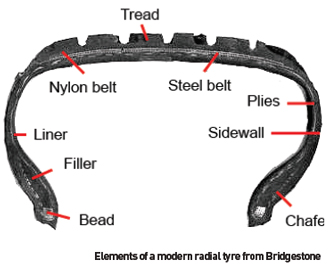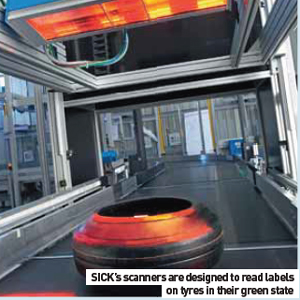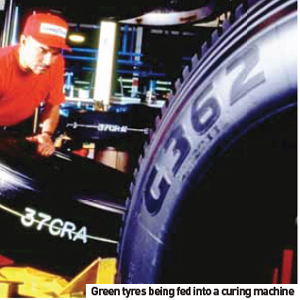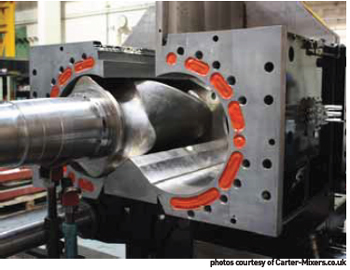
As tyre production shifts location in response to changing global vehicle demand, so manufacturers are bringing in more automation
Tyres are seen by many in the automotive industry as a commodity, a component that cannot significantly contribute to cost savings or optimised production in terms of manufacturing. While this may be broadly true, there is no doubt that efficient tyre production can help OEMs to reduce vehicle unit costs, while also contributing to fuel and emissions savings and improving vehicle safety.
Further to this, tyre production is a good barometer of global labour cost differentials; it has continually moved to low-cost countries, with current expansion focused in China and India. Indeed, the pattern of production volume saw tyre makers first move to eastern Europe, then to South Korea and Malaysia, and now to China. This trend is most apparent in new plants and with newer tyre companies, or those that have recently entered the global sales and supply arena. That said, established players have also favoured starting operations in low-cost countries.
 Following this trend, and perhaps leading it in some ways, has been the rise of tyre-making equipment providers in developing regions. An example of this is the recent news that Japan’s Kobe Steel has formed a 49/51 joint-venture with Indian engineering and construction firm Larsen & Toubro, to produce and sell rubber processing machinery in India.
Following this trend, and perhaps leading it in some ways, has been the rise of tyre-making equipment providers in developing regions. An example of this is the recent news that Japan’s Kobe Steel has formed a 49/51 joint-venture with Indian engineering and construction firm Larsen & Toubro, to produce and sell rubber processing machinery in India.
The new company, called L&T Kobelco Machinery, will make rubber mixers and twin screw rollerhead extruders used in tyre manufacturing at a new Rs500 million ($11 million) plant that will enter production in October this year. A direct response to growing tyre demand in emerging markets, the joint-venture is a natural extension of both partners’ activities, as Kobe Steel currently manufactures tyre and rubber machinery in Japan, the United States and China, while Larsen & Toubro is India’s top manufacturer of tyre curing presses.
To better understand the global machine market in this sector, it can help to examine the processes and equipment used in tyre production. Tyre plants are traditionally divided into five areas, acting almost as independent facilities within a single plant. Large tyre makers may set up independent facilities on a single site, or cluster these activities within a region, a flexibility brought about by the fact that no individual part of tyre production requires extraordinary amounts of energy, water or other commodities, unlike may other vehicle making processes.
Compounding describes the assembly of all the ingredients required to mix a batch of rubber. Mixing is carried out in large machines known as ‘Banburys’, often equipped with two contra-rotating rotors in a large housing that both break up and mix the rubber ‘load’ and required additives.
The mixing is done in three or four stages and generates considerable heat, so the rotors and the housing are watercooled to maintain a temperature low enough to prevent vulcanization.
After mixing, the rubber charge is dropped into a chute and fed by an extruding screw into a roller die. Alternatively, the batch can be dropped onto an open rubber mill batchoff system. This is similar to rolling out pastry and as well as flattening and thinning the rubber mix, it provides additional mechanical working to the rubber and produces a thick rubber sheet. The sheet is pulled off the rollers in the form of a strip, which is then cooled and dusted with talc before being laid down into a pallet bin.
The compound, while looking from the outside to be evenly mixed, is still quite unfinished in its make-up. At this stage, such elements as the carbon black (used to give reinforcement and build abrasion resistance) may not be well mixed with the rubber or the additives as mixers are often controlled by load measurement, which means that the mixing will stop once a fixed amount of electric current is delivered to the motor.
 Components fall into three classes based on manufacturing process: calendering, extrusion, and bead building.
Components fall into three classes based on manufacturing process: calendering, extrusion, and bead building.
The extruder machine consists of a screw and barrel, screw drive, heaters, and a die. The extruder applies two forces to the compound, heat and pressure, while also providing additional mixing of the compound, completed through the shearing action of the screw. The compound is pushed through a die, after which the extruded profile is vulcanized (heated to improve its properties) in a continuous oven, cooled, and either rolled up on a spool or cut to length.
Tyre treads are often extruded with four components in a quadraplex extruder, with four separate screws processing four different compounds, usually consisting of a base, core, tread, and wing. Extrusion is also used for sidewall profiles and inner liners. The inner liner is made from a sheet of halobutyl rubber, mixed with additives to make it airtight.
The calender is a set of multiple large-diameter rolls that squeeze the rubber compound into a wide, thin sheet. Fabric calenders produce an upper and lower rubber sheet with a layer of fabric sandwiched in between. Steel calenders do the same but with steel cords interspersed, making ‘steel-belted’ tyres. Calenders are also used to produce body plies and belts.
Tyre building is the most labour-intensive and potentially dangerous operation in the tyre making process and while tyre building machines (TBM) can be manually operated or fully automatic, globally the majority are manual. The so-called first stage operation in a TBM is where the inner liner, body plies and sidewalls are wrapped around the drum. With the beads in place, the assembly is turned up over the bead. In the second stage operation the belt package and tread are applied and the green tyre is inflated and shaped.
All these components require splicing, with the inner liner and body plies spliced with a square-ended overlap. Tread and sidewall are usually joined with a skived splice, while the joining ends are bevel-cut. Belts are spliced end-toend with no overlap. The green product built in the TBM process refers to a tyre in its uncured state.

Tyre manufacturing is one the few major commodity production areas where some manual tasks are not easily replaceable by machine. But where man and machine interact so sensor technology can contribute to increased safety and effi ciency. AMS spoke to André Hack, Strategic Industry Manager at SICK Sensor Intelligence, to ask about managing the man-machine interface and machine monitoring by sensor.
AMS: What is the earliest stage in tyre making where SICK equipment might be involved?
AH: In mixing and compounding. We have sensors to measure thickness of the extruded material. The levels of the rubber mix are monitored by SICK sensors, using level switching for a ‘not full/full’ type of go and nogo sensor operation, as well as actual volume measurement, depending on the application.
AMS: Where are sensors used in tyre building?
AH: Tyre building machines are very complex machines that still require close human co-operation. Therefore TBMs are considered safety-critical as workers must stand and work in front of machines with spinning drums. To improve safety in this area, SICK supplies different kinds of safety equipment, ranging from scanners and light curtains to intelligent controllers. Solutions from SICK allow the worker to be closer to the machine while still being safeguarded.
In additon, we also supply and install scanners that go beyond basic area protection. One single scanner can intelligently monitor the working area in front of a TBM using a technology we call simultaneous field evaluation, operating in a 2D plane of up to 7m in 190 angular degrees.
For example, we can design in several protective fields linked to the machine and dynamically evaluate if an area is safe to enter or not.
This means that different production phases can be run with workers in various areas and proximities. One process can take place with someone standing close to a machine and another may demand that the worker stand further away. It can help to improve efficiency while safety is not compromised.
Equipment such as this replaces safety mats that had the switches built in, which need periodical replacement. In calendaring, automation of the control of ‘loops’ of the different plies of rubber and fabric is a big field of application for sensors. With this, the machines compensate different roll-off speeds into constant feed-in speeds to allow matching lengths of material. With our range of sensors for ‘loop control’, we can offer solutions for this for all different types of material and dimensions.
 AMS: And how can you help to automate identification and tracking of tyre products?
AMS: And how can you help to automate identification and tracking of tyre products?
AH: The tracking of tyres throughout the production process is very important. At SICK, code reading and RFID is one of our main fields of expertise and therefore it’s a big technological focus for us in the tyre industry. In the green tyre phase, in curing, and all the way up to delivery, code-readers are used to sort and identify tyres.
Tyres have special demands because of their round shape, the label can be anywhere, upside down, etc. As a tyre may be fitted with a barcode label in its green state (before curing), the label can be damaged in later processes. Scanners or camera-based code readers must always be able to read any labels as any ‘non-read’ situation is very expensive, the tyre must be removed from the line and the problem fixed by hand.
If the code can be seen at all by the camera or scanner, we say that our latest equipment will be able to read all the information - the reader can even read through the small gaps on a roller conveyor. Our customers are demanding 100% accuracy.
Automation and the man-machine interface
Pirelli Tyre has developed a special process, called MIRS, that uses robots to position and rotate the building drums under stations that apply the various components, usually via extrusion and strip winding methods. This permits the equipment to build different tyre sizes in consecutive operations without the need to change tooling or setup.
The process is well suited to small-volume production with frequent size changes.
The largest tyre makers have internally-developed automated tyre-assembly machines, with the goal of reducing labour while improving precision and increasing production yield.
Curing is the process of applying pressure to the green tyre in a mould to give it its final shape, while also applying heat energy to stimulate the chemical reaction between the rubber and other materials. In this process the green tyre is automatically transferred onto the lower mold bead seat, while a rubber bladder is inserted into the green tyre. As the mould is closed, the inflating bladder pushes the tyre against the inside of the mould, which is lined with the tread pattern and sidewall information. The bladder is then filled with a recirculating heat transfer medium, such as steam, hot water, or inert gas. Interior temperatures can reach 350oF, with pressures around 350psi.
Car tyres cure in approximately 15 minutes. Once the process is complete, the tyre is sometimes placed on a PCI, or post-cure inflator, that will hold the tyre fully inflated while it cools. There are two generic curing press types, mechanical and hydraulic. Mechanical presses hold the mould closed using toggle linkages, while hydraulic presses employ lock the mould with a breech-lock mechanism.
Hydraulic presses have emerged as the most cost-effective solution as the press structure does not have to withstand the mould-opening pressure and can therefore be relatively lightweight. There are two generic mould types, two-piece molds and segmental moulds. In the case of large off-road tyres, curing is often carried out in ovens, with cure times approaching 24 hours.
After the curing process has been completed, there are several final operations. Tyre uniformity measurement involves the tyre being automatically mounted on wheel halves, inflated, run against a simulated road surface, and measured for force variation. As it implies, tyre balance rotates the tyre at high speed to check for imbalance.
Large commercial truck and bus tyres, as well as some passenger and light truck tyres, are inspected by X-ray machines that can penetrate the rubber to analyze the steel cord structure and look for air bubbles and other faults. Tyres are often also inspected by operator, looking for numerous visual defects such as incomplete mould fill, exposed cords, blisters and blemishes.
 To get an insight into tyre production from a manufacturer, AMS spoke to Mark Sears, Chief Design and Development Engineer for Dunlop Motorcycle Tyres, at the company’s Erdington, UK facility.
To get an insight into tyre production from a manufacturer, AMS spoke to Mark Sears, Chief Design and Development Engineer for Dunlop Motorcycle Tyres, at the company’s Erdington, UK facility.
AMS: How do you check and assure raw material stocks?
MS: I am the internal auditor for the company, so I carry out a weekly internal audit on every area of the plant. We are supplied from our sister plants at Hanau in Germany and Montlucon, France, and also from Dupont and Akzo Nobel.
We insist on BSI accreditation, or TUV if it is from Germany. When product comes in, we have a dedicated team that carries out a daily stock check. Anything wrong is embargoed and sent back or put into a different usage, like a central compound, which is not so critical. For testing carbon black, we use a microscope to check that the carbon particles are properly dispersed in the tread compound. For textile plies, we will physically test for strength, humidity and the adhesion levels of textile when it has been dipped in the solution that helps it adhere to the carcass construction. The raw cord comes in already dipped.
AMS: What abut shelf life of tyres and components in the process?
MS: A green tyre (uncured) has a shelf life of just 24 hours and tread compound has a shelf life of five days. Storage conditions are vital, as a green tyre has no strength or integrity so it can easily deform and become useless.
 AMS: The steel bead wires, are they plated or treated?
AMS: The steel bead wires, are they plated or treated?
MS: The bead wire is high-tensile steel, sourced from Otto Kuhlmann in Germany, which also supplies Michelin and Pirelli and some other tyre makers. The wire is copper plated, which prevents corrosion in storage and is the right finish to take the rubber coating. Bead wire comes in either a spiral that is wrapped in a fabric, or the ends are brazed together, or joined with a brass ferrule. Typically a car tyre will have one bead, whereas an aircraft tyre has three beads for extra strength and to prevent the tyre rolling off the rim.
AMS: What ingredients go into the mix here at Dunlop tyres?
MS: There can be up to 45 elements in the compound that go through the Banbury mixer. It then gets cooled and stacked ready for building. We store all the ingredients in disposable containers that there is no waste when it is dropped into the mix.
AMS: In curing, how have processes changed?
 MS: Traditionally, a bladder or diaphragm would be put inside the green tyre and a medium such as steam would be injected to push the carcass out into the mould; the heat then cures the carcass. We now use nitrogen as the pressure medium. In short runs, we might use a sand compound that becomes solid under vacuum. To release the tyre, the vacuum is released and the mould opens. After it comes out of the mould, it is put into a post-cure inflation mould (PCI), a two-piece wheel, and inflated to 2.5 bar pressure to cool down for about 15 minutes, allowing it to set to the correct shape.
MS: Traditionally, a bladder or diaphragm would be put inside the green tyre and a medium such as steam would be injected to push the carcass out into the mould; the heat then cures the carcass. We now use nitrogen as the pressure medium. In short runs, we might use a sand compound that becomes solid under vacuum. To release the tyre, the vacuum is released and the mould opens. After it comes out of the mould, it is put into a post-cure inflation mould (PCI), a two-piece wheel, and inflated to 2.5 bar pressure to cool down for about 15 minutes, allowing it to set to the correct shape.
AMS: How is testing and inspection carried out?
MS:An operator will take the tyre off the PCI and put it into the trimming and viewing area for inspecttion. The first stage is a conveyor run to a balancing machine where it will identify the heavy spot and mark the carcass opposite this, usually with a red dot. This mark should be placed at the valve area when the tyre is fitted to a rim or wheel. From here it will be conveyered to an X-ray machine that looks for any trapped air, breaker concentricity. (These are internal variations, not runout, as this will be found by the force variation tester that comes next).
The force variation machine will run the tyre against a drum under a light load. The drum is fitted with sensors, and can measure any in-built forces in the tyre, radial and lateral runout in three positions, crown and shoulders. It basically measures differences in resistance to turning but not co-efficient of friction or rolling resistance.
Every tyre will have its history recorded during testing and this will be identified by a barcode label or RFID tag.
This means the tyre is traceable and if it is returned with an alleged fault, we can track back and check that all its test criteria were correct. Once these tests are completed, the tyre is conveyored to the dispatch area.
AMS: How will we see tyres changing in the future?
MS: The advances in the chemistry of compounds will result in slick or less heavily treaded tyres being designed for road use. This may sound extraordinary, but there are microporous compounds coming in that will absorb water and disperse it as fast as tread patterns, or sipes, that are currently used to clear water. The big advantage of this in manufacturing will mean the end of having to mould tread patterns into tyres using expensive mould making techniques, while the end user will gain exceptional levels of grip and a longer-lasting tyre, with none of the heat generation and distortion associated with deep, heavy tread patterns.
In construction terms, we will see hybrid, lightweight materials like Kevlar, carbon fibre and polyethylene acrylates. This is important as a car tyre typically weighs 8kg, and there are of course four of them.
AMS: What about recycling rejected tyres?
MS:We use a local recycler who grinds them into pulp or granules for brick making or to be used for soft ‘flooring’ material in children’s playgrounds.































